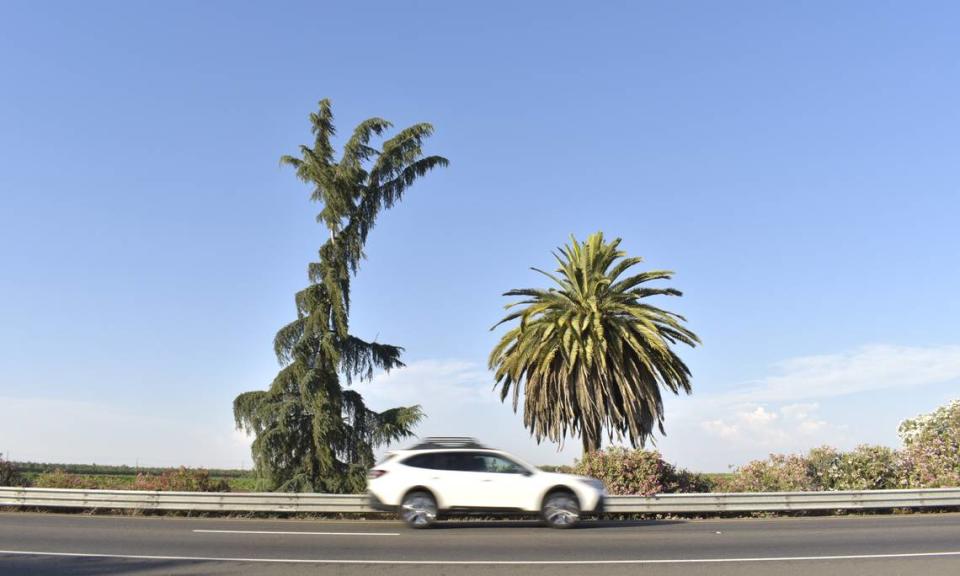Highway 99’s Palm and Pine will be removed next year. What’s next for the California landmark?
You could speed past it at 80 mph dozens of times and not know it.
“It’s lost in the midst of the Oleander in the median,” said Michael Ballard, president of the Historic Highway 99 Association of California. “It is something that, unfortunately, I see goes more unnoticed.”
The Palm and the Pine, a geographic marker made up of a Canary Island date palm tree to the south and what is actually a Deodor cedar tree to the north, symbolizes the split between California’s northern and southern halves. The landmark’s exact origins are uncertain, but it is generally agreed upon that it has stood in the center divider of Highway 99 in Madera, about halfway between Avenues 9 and 12, since the 1920s.
“There’s this fascination that we’re in the center of it all here in the Central Valley,” author and Merced-based columnist Steve Newvine told The Fresno Bee.

Advocates for the palm and the pine, like Newvine and Ballard, have been hoping for years to get some sort of official marker placed at the location.
But the trees will be removed during the fall of 2025 because of the construction project set to widen Highway 99 between Avenues 7 and 12 from four to six total lanes. The project includes placing a concrete center divider in the highway.
However, it’s not the end for the landmark that has been on TV shows, in books and even in a country song by Danny O’Keefe about a young man’s relationship with an older woman. (She’d thrown away her crutches, but I knew that I’d need mine / In Northern California where the palm tree meets the pine.)
Larry Johnson, a spokesperson with the Caltrans District 6 office, told The Bee that the palm and the pine will be replaced with a new marker of the divide between California’s north and south — one that sticks out a little more at drivers on Highway 99.
Off of the west side of the highway, hopefully in the same vicinity or the same general area, Johnson said, the new landmark will feature 15 palms representing Southern California and 15 pines representing Northern California. The trees will also have their own irrigation system to keep them from dying.
Trees’ roots stretch 100 years (more or less)
Those who have researched the origins of the palm and the pine have found little official record of how, when and why the trees were planted.
The landmark was featured on the TV show California’s Gold, hosted by Huell Howser, in 1995, when the trees inspired the late host to search for California’s geographic center. Some origin stories say the trees predate the construction of Highway 99 and could have been planted by university students or owners of a store that stood in that area before the roads did, as blogger Duane Hall wrote in 2010.
Caltrans told Howser that it could not find any records about the landmark’s origins on Highway 99, which was built in the 1920s.
But fourth-generation Madera rancher Jim Erickson, whose great-grandparents bought the land in that stretch of the highway in 1924, said his father, Stephen, always told him those trees were there before the highway.
“According to my father, that palm tree and pine tree was in the front of the house back then,” Erickson said, “and in ‘48, they put the southbound lanes in and they moved my great-grandfather’s house back. It sits back in the orchard now.”
The pine tree fell over in 2005, but Caltrans planted a new one a few years later — amid “kind of a big uproar” calling for its replacement, Madera County Supervisor Robert Poythress said.
It also was eventually discovered that California’s true geographic center is actually near North Fork in Madera County’s mountains.
But to Newvine, that is not the most important thing about the palm and the pine.
“What’s important is that it’s been maintained,” he said. “It’s a neat look at how we look at what is important in our history.”

The Land of the Palm and the Pine
Newvine first noticed the interest around the landmark after writing a column about it on a Merced County events website. He said his webmaster noticed the story got more traffic than any other Newvine had ever written for the site.
He decided to use “the palm and the pine” in the subtitles for three books he’s written about California:
▪ “California Back Roads: Stories from the land of the palm and the pine”
▪ “Beaten Paths & Back Roads: California Stories in the Land of the Palm & the Pine”
▪ “Can Do Californians: Determination & Inspiration in the Land of the Palm and the Pine”
“That’s where I get the reaction — the palm and the pine,” he said.
The landmark has also been used in the name of a Fresno brewery: Pine & Palm Brewing, which is temporarily closed but set to reopen, owner Roger Noguera said.
Ballard, of the Historic Highway 99 Association, said his group has worked with local governments across the state — from Calexico on the southern border to Fresno and the city of Madera — to get signs placed on historic roads. He hopes to do something similar for the palm and the pine on Highway 99, the road he calls “the workhorse.”
“We’re trying to promote the old highway, trying to revitalize it and get people to take the old road instead of the freeway,” Ballard said. “There’s a lot to see. There’s a lot to do.”

